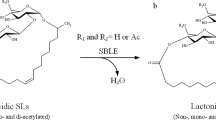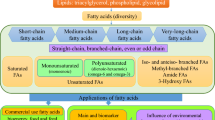Abstract
n-Alkanes ranging from C12 to C18 were converted into glycolipid biosurfactants, mannosylerythritol lipids (MEL), by resting cells of Pseudozyma (Candida) antarctica T-34. The highest yield (0.87 g g−1 substrate) was obtained from 6% (v/v) of n-octadecane after 7 days reaction. The amount of MEL reached 140 g l−1 by intermittent feeding of the substrate.
Similar content being viewed by others
References
Bai G,Brusseau ML,Miller RM (1997) Biosurfactant-enhanced removal of residual hydrocarbon from soil. J. Contam. Hydrol. 25: 157-170.
Banat IM,Makkar RS,Cameotra SS (2000) Potential commercial applications of microbial surfactants. Appl. Microbiol. Biotechnol. 53: 495-508.
Daniel HJ,Reuss M,Syldatk C (1998) Production of sophorolipids in high concentration from deproteinized whey and rapeseed oil in a two stage fed batch process using Candida bombicola ATCC 22214 and Cryptococcus curvatus ATCC 20509. Biotechnol. Lett. 20: 1153-1156.
Kitamoto D,Sangita G,Ourisson G,Nakatani Y (2000) Formation of giant vesicles from diacylmannosylerythritols, and their binding to concanavalin A. Chem. Commun. 2000: 861-862.
Kitamoto D,Yanagishita H,Endo A,Nakaiwa M,Nakane T,Akiya T (2001) Remarkable antiagglomeration effect of a yeast biosurfactant, diacylmannosylerythritol, on ice-water slurry for cold thermal storage. Biotechnol. Progr. 17: 362-365.
Kitamoto D,Yanagishita H,Haraya K,Kitamoto HK (1998) Contribution of a chain-shortening pathway to the biosynthesis of the fatty acids of mannosylerythritol lipid (biosurfactant) in the yeast Candida antarctica. Biotechnol. Lett. 20: 813-818.
Kitamoto D,Yokoshima T,Yanagishita H,Haraya K,Kitamoto HK (1999) Formation of glycolipid biosurfactant, mannosylerythritol lipid, by Candida antarctica from hydrocarbons via subterminal oxidation pathway. J. Oleo Sci. (formerly J. Jpn. Oil Chem. Soc.) 48: 1377-1384.
Rattray JBM (1988) Yeasts. In: Ratledge C,Wilkinson SG, eds. Microbial Lipids, Vol. 1. New York: Academic Press, pp. 555-697.
van Beilen JB,Wubbolts MG,Witholt B (1994) Genetics of alkane oxidation by Pseudomonas oleovorans. Biodegradation 5: 161-174.
Vollbrecht E,Rau U,Lang S (1999) Microbial conversion of vegetable oils into surface-active di-, tri-, and tetrasaccharide lipids (biosurfactants) by the bacterial strain Tsukamurella spec. Fett/Lipid 101: S. 389-394.
Wakamatsu Y,Zhao X,** C,Day N,Shibahara M,Nomura N,Nakahara T,Murata T,Yokoyama KK (2001) Mannosylerythritol lipid induces characteristics of neuronal differentiation in PC12 cells through an ERK-related signal cascade. Eur. J. Biochem. 268: 374-383.
Zhao X,Wakamatsu Y,Shibahara M,Nomura N,Geltinger C,Nakahara T,Murata T,Yokoyama KK (1999) Mannosylerythritol lipid is a potent inducer of apoptosis and differentiation of mouse melanoma cells in culture. Cancer Res. 59: 482-486.
Author information
Authors and Affiliations
Rights and permissions
About this article
Cite this article
Kitamoto, D., Ikegami, T., Suzuki, G.T. et al. Microbial conversion of n-alkanes into glycolipid biosurfactants, mannosylerythritol lipids, by Pseudozyma (Candida antarctica). Biotechnology Letters 23, 1709–1714 (2001). https://doi.org/10.1023/A:1012464717259
Issue Date:
DOI: https://doi.org/10.1023/A:1012464717259




